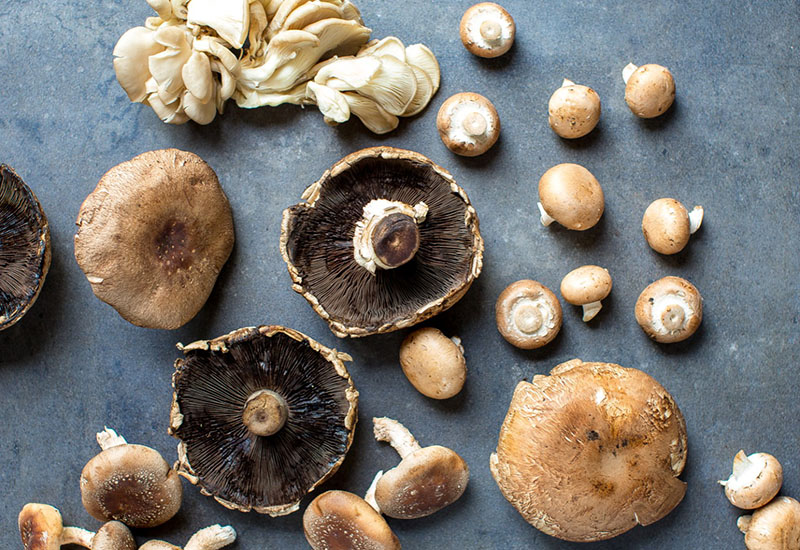Making the Most of your Mushrooms

Are you a mushroom person? Whether or not you are a fan of these fungi, one thing is certain: mushrooms have the stigma of being difficult to select, store and clean. In reality, cooking with mushrooms is not as daunting as it seems. All you need are a few simple tips and tricks and you will be on your way to mastering the art of cooking with mushrooms.
How to Shop for Mushrooms
I like to buy loose rather than pre-packaged mushrooms so you can inspect their condition and quality. Look for mushrooms with whole, intact caps and avoid those with discoloration or dry, shriveled patches. The mushrooms should feel faintly damp, but never moist or slimy, and their texture should be springy and light rather than spongy.
The aroma is another important indicator of quality and intensity—the stronger the sweet, earthy scent, the more potent and flavorful the mushrooms. Don’t buy mushrooms if they smell sour or fishy, and be sure to pick ones with large caps and minimal stems since the stems are often discarded.
How to Store Mushrooms
Due to their high moisture content, mushrooms are very perishable. They can go from plump to shriveled and slimy in no time.
• DON’T wrap mushrooms in a paper bag, as many sources suggest. It turns the fungi spongy and wrinkly.
• DON’T cover mushrooms with a damp paper towel (another common technique), as it only speeds up their deterioration.
• DO store loose mushrooms in a partially open zipper-lock bag, which maximizes air circulation without drying out the mushrooms. Leaving the bag slightly open allows for the release of the ethylene gas emitted from the mushrooms.
• DO store packaged mushrooms in their original containers. These containers are designed to “breathe,”’ maximizing the life of the mushrooms by balancing the retention of moisture and release of ethylene gas. If you open a sealed package of mushrooms but don’t use all the contents, simply re-wrap the remaining mushrooms in the box with plastic wrap.
How to Clean Mushrooms
Should You Wash Mushrooms You’re Going to Cook?
If they’re whole, yes. Although many sources advise against washing mushrooms (to avoid their soaking up any additional moisture) and suggest brushing them instead. Since mushrooms are about 80% water they actually do not soak up much additional water. Contrary to popular belief, a quick rinse for whole mushrooms is suggested.
Cut mushrooms are a different story. The exposed flesh will absorb more water, so rinse mushrooms before slicing them. And be careful not to wash mushrooms until you are ready to cook them or they will turn slimy.
Should You Wash Mushrooms You’re Serving Raw?
In a word, no, because rinsing mushrooms can cause discoloration, and you want your meal to look as good as it tastes. I recommend cleaning mushrooms that will be served raw by brushing them with a dry, soft toothbrush.
How to Clean Portobello Mushrooms
- Remove the stems.
The stems of large portobell0s, while technically edible, can be woody and fibrous and are usually discarded or used to flavor stock. They should pop right out when you pull on them with your fingers. - Remove the gills
Likewise, the dark black gills can be eaten, but they’ll turn your food brown, so it’s best to scrape ’em out. The key here is to pry with the tip of a spoon instead of just going at it with the side of the spoon. It should come out in neat, discrete chunks instead of staining the whole cap (and your fingers). It can be easy to ding up the sides of the mushroom as you do this, but it’s ok — it’ll look just fine once it’s done cooking.
When cooking the cap whole, it’s best to score it lightly on the top side. This allows steam from inside to escape more easily, which both hastens cooking and makes it more even. It also prevents the mushroom from distorting as it shrinks while it cooks. If you’re planning to use a marinade, it’ll also provide access channels for flavors to penetrate more deeply.
How to Clean Shiitake Mushrooms
Fresh shiitakes have a distinct flavor that makes them great in Asian soups (many recipes actually call for more intensely flavored dried shiitake), but also work really well sautéed, fried, or grilled.
- Remove the stems.
With portobello stems, discarding is a matter of personal taste. With shiitake, it’s not an option. The stems are tough and leathery. They’re also stuck to the caps more firmly than most other mushrooms. To remove them, pinch the stem very firmly at the base right where it meets the cap. Slowly and gently pry off the stem, trying to remove as little of the inner cap material as possible.
Once the stems have been removed, you can further break down shiitake by cutting them into quarters (great for larger caps on the grill or stir-fries), or by slicing them thinly across the cap.
How to Clean Oyster Mushrooms
The easiest of the bunch, Oyster mushrooms come bundled in a large group, all attached to the same central stem. To clean oyster mushrooms, just use the tip of a sharp knife to carefully cut around the firm central stem and watch as the individual caps fall away. Discard the stem or reserve it for adding to stock.


